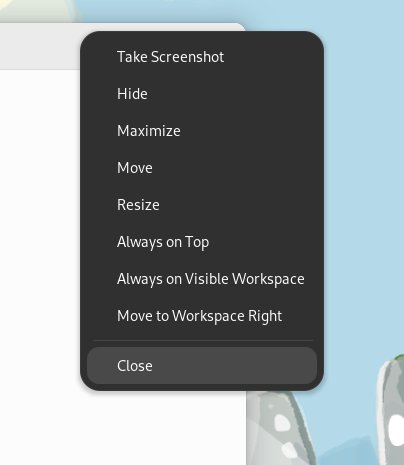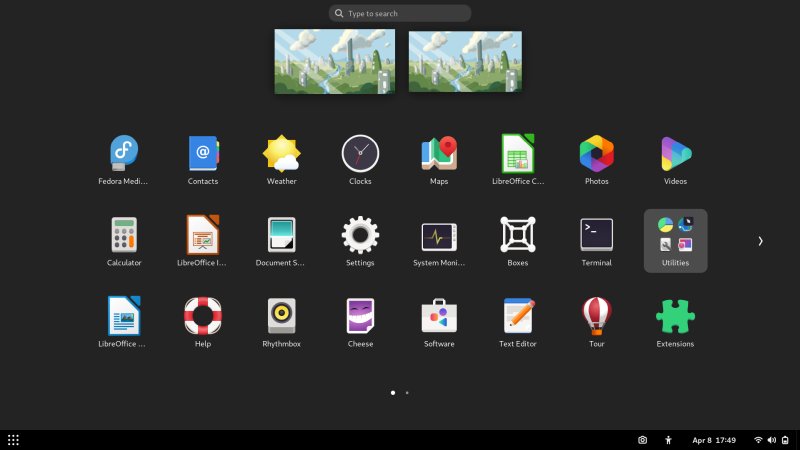Updated: April 28, 2023
I know, I know, I know I'm late to the party, and that Fedora 38 will have been, by the time you read this article, officially released (yup). That said, having recently tested MX Linux 21.3 Wildflower, I felt a tiny surge of curiosity vis-a-vis Linux distro testing, and I decided to extend it a little bit, and include Fedora in this effort.
Now, you know how I feel regarding the Gnome desktop. That ain't new, nor will it change dramatically, nor should you expect any major, revolutionary findings on my behalf here today. But one cannot deny the value and importance of Fedora in the Linux world, whatever its usecase or message may be. Still, as an end user, I want to see what it can do, and ... can it do what I expect it to do? Let us proceed.
The question of desktop ...
Desktop, a 40-year-old concept that defines a user interface, primarily driven by the mouse cursor. Now, not everything that is driven by a mouse is a desktop, but close. At the very least, the couple of billions of Windows machines, the slew of macOS machines, and a sprinkling of Linux machines out there all pretty much adhere to the concept, almost uniformly. The basics are: some sort of task manager that allows the user to interact with system resources, some sort of menu to access applications, shortcuts to said applications positioned on the "desktop", and task management. This is more or less how things have been done since forever, with only small variations, primarily cosmetic.

Gnome 3 does things its own way, and my taste of Fedora 37 confirms that very little has changed since the early days of this desktop environment, and if anything, things are even worse in terms of basic desktop usability. Yes, power users can use keyboard shortcuts. Not interested. The question is how would a McNormie navigate Gnome without being helped by a helpful nerd at their side. Indeed, my long-standing complaints still stand:
- There is no menu - you get Activities, you're supposed to figure out this is what the menu ought to be, but then it's not a menu in any classic shape or form. So to get an overview of your running programs, or to access application shortcut, you need an extra mouse click.
- The network connectivity icon is hidden in the tiny would-be menu on the right. Except, again, this ain't no menu. There's not even an indication that the area that shows the volume and battery indicators is actually clickable. Expand to activate Wireless. Another unnecessary mouse click. Why is Volume shown but Wireless not? Is it somehow lesser in hierarchy?

- No desktop icons.
- No show desktop function anywhere.
- The application windows have no min/max button (by default). In fact, if you use the Gnome's new (double) right-click context menu, there's Maximize, but no Minimize. Also, with Firefox, without the Title Bar, things are even worse.

- Files (file manager) won't let you create text files via right-click.
But let's focus on the distro ...
Hard. I tried my best to use the system, even in the live session, but the ergonomics were just off. One, my test laptop comes with a 14-inch screen, with 1920x1080px resolution, too tiny to view comfortably at 1:1 scaling. In other operating systems and desktop environments, I use fractional scaling, e.g.: 125%. This works rather well, say in Plasma. But Gnome, by default, unless you activate a hidden gsetting, will not let you use fractional scaling. It's either 100% or 200%. Useless.

Notice the bad font contrast, too ...
I did change font scaling - to 1.25, and this worked kind of okay. Fedora 37 uses decent AA/Hinting settings, slight and grayscale, respectively. But then, the latter ought to be RGB, methinks. Now, how do I know this? Well, I installed Gnome Tweaks, to be able to modify the desktop environment so it's proper usable.

- Indeed, I installed Gnome Tweaks, this took care of font scaling - can't do so via normal Settings, I added the min/max buttons, and made a few other rudimentary yet critical changes.
- For a while now, Gnome Tweaks no longer handles extensions - it tells you to grab the Flatpak version from Flathub, which you need to configure first (I believe Fedora 38 fixes this, finally), and if you don't know how, you're stuck. But then, there's Gnome Extensions in the repos, and it works fine. Except it's not used to install extensions, only manage existing ones.
- I did try to install Dash to Panel from the repo,and that didn't work. I then opened the Gnome Extensions website, installed the Firefox add-on, and then activated the aforementioned extension, and I finally had a normal panel at the bottom of my screen, with application shortcuts, show desktop button, and all that.
Well, in the end, I did all of the tricks I always had to do to make Gnome usable as a classic desktop, without wasting time on unnecessary mouse clicks or working with a sense of visual deprivation.

But things were still kind of rough. Various Gnome programs use their own theming, ignoring my system wide settings. For instance, even though I use the light theme, Boxes or Cheese are always dark-themed, no matter what. Their window button controls also seem to be different from Files, for instance. If you hover your mouse cursor over the Files control buttons, they will be highlighted, but not so in the other applications.

Who cares that I use a light-themed desktop, right?

The font feels pale, especially inside the text editor. Here, I encountered a bunch of other inconsistencies. Because Gnome 3 does not use classic file menus, everything goes into a handful of "hamburger" menus on the right side. Great for smartphones, not for desktops. But anyway, because the real estate is thus limited, the different icons serve totally unrelated functions. They are hard to decipher symbolically as say View actually looks like a document with a wrench attached to it. Again, View also covers Check Spelling. How's Spelling relevant here? Perhaps it's there because you see or not see the squiggly red lines? Regardless, that does not solve the issue of awful font contrast. I like nice fonts, especially if they are used right, say Ubuntu, Noto, IBM Plex, Rubik, Droid, but that ain't happening here, unfortunately.


My eyes are watering just looking at that text. Also, no real border between text tabs.
I noticed the applications are not sorted in the app overview. So you need to hunt visually and figure out what to click. Seems like everything is designed to require extra mouse clicks for some reason. Even the folders aren't shown before files in the file manager as a default option.

The screenshot tool infuriated me. It's this new weird overlay tool. You can't invoke it as a program. Nope. It hovers over the bottom of your screen, it doesn't look like the rest of the Gnome app stack, and it's extremely limited. I couldn't find an option to select where to save screenshots, or rename them, and there's no timer, nor an option to remove huge and unnecessary alpha borders. But if you install a screenshot extension, this one renders with the old Gnome screenshot look, plus all of the right options. Weird.


The screenshot tool above only works through the Extension, not the default Fedora 37 tool. BTW, you cannot take a screenshot of the screenshot tool unless you use another application, because it has no timer, nor can you run more than one instance. But even with the extension, there be quirks.
Finally, the responsiveness wasn't amazing. Better than it was before, Gnome wise, but definitely not as sprightly as some other desktop environments, on this very hardware, live session and all. I mean Gnome has improved significantly on the performance side in the last few years, but there's more work to be done.
Time to install ...
And I decided, much like the Xfce part of my recent MX Linux test, that I would not. There would be no value to such an exercise. If anything, I'd be using Fedora with heavy modifications and tweaking, after which all of the essential Gnome-ness would be undone. So what's the point, right? I should probably stop wasting your time, dear readers. To wit, the summary of me work ...
Conclusion
What did we learn here today? Not much. Did I review Fedora 37? Not per se. Then again, yes. I mean, you interact with the operating system in some way, and if that initial interaction is mostly frustrating and difficult, then there's no point going on. I found myself wasting mouse clicks, and my eyes tingling from sub-optimal UI settings, be it colors, font choice, or else. I realized I was doing a pointless ritual of undoing Gnome defaults to get a classic desktop scheme. That's just unnecessary.
Fedora also comes in other guises, including Plasma. Perhaps there, I could discover the wonders of its tech stack. And usually, Fedora has a lot of decent, new stuff. But there's no LTS, it's all short-lived bleeding-edge tech, and you also need to hunt for proprietary stuff if you wanna do conventional fun. All in all, it makes no sense for everyday usage, especially if you want peace and quiet.
And yes, Fedora has become quite stable in the last few years, and there's no real feeling of "beta" about it anymore, but even so, I don't want to be upgrading my operating system, pretty much ever, let alone every few months. Then, for a given distro, overall usability, efficiency and performance will be closely tied to the choice of the desktop environment, so the conclusion there is quite obvious. Anyway, I vowed a couple of years back to stop doing distro reviews for the sake of it, and focus on my fun factor. There was little of it to be had today, so I cut the review short. I think I'll have a look at Fedora 38 Plasma soon, but I don't think I will try the stock Gnome release any time soon. That venue will have a consistent outcome for me, alas. Take care, fellow Tuxers, see you around.
Cheers.